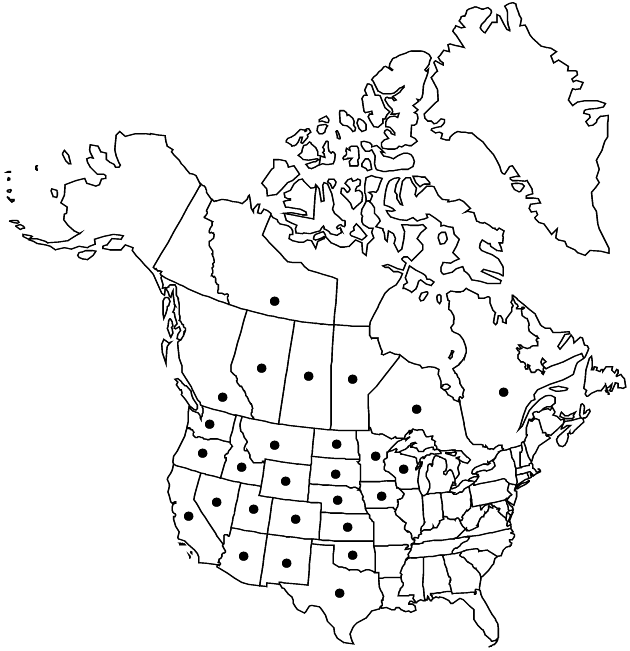Difference between revisions of "Symphyotrichum lanceolatum var. hesperium"
Phytologia 77: 284. 1995.
FNA>Volume Importer |
FNA>Volume Importer |
||
| Line 7: | Line 7: | ||
|year=1995 | |year=1995 | ||
}} | }} | ||
| − | |basionyms={{Treatment/ID/ | + | |basionyms={{Treatment/ID/Basionym |
|name=Aster hesperius | |name=Aster hesperius | ||
|authority=A. Gray | |authority=A. Gray | ||
| + | |publication_title=in A. Gray et al., Syn. Fl. N. Amer. | ||
| + | |publication_place=1(2): 192. 1884 | ||
}} | }} | ||
|synonyms={{Treatment/ID/Synonym | |synonyms={{Treatment/ID/Synonym | ||
| Line 53: | Line 55: | ||
|elevation=10–2700 m | |elevation=10–2700 m | ||
|distribution=Alta.;B.C.;Man.;N.W.T.;Ont.;Que.;Sask.;Ariz.;Calif.;Colo.;Idaho;Iowa;Kans.;Minn.;Mont.;Nebr.;Nev.;N.Mex.;N.Dak.;Okla.;Oreg.;S.Dak.;Tex.;Utah;Wash.;Wis.;Wyo.;Mexico (Baja California;Chihuahua;Sonora). | |distribution=Alta.;B.C.;Man.;N.W.T.;Ont.;Que.;Sask.;Ariz.;Calif.;Colo.;Idaho;Iowa;Kans.;Minn.;Mont.;Nebr.;Nev.;N.Mex.;N.Dak.;Okla.;Oreg.;S.Dak.;Tex.;Utah;Wash.;Wis.;Wyo.;Mexico (Baja California;Chihuahua;Sonora). | ||
| − | |discussion=<p>Variety hesperium is present at the northeastern limit of its range in Quebec only on the clays of the southern James Bay; a report of introduction in the Gatineau area is attributable to <i>Symphyotrichum robynsianum</i>. In north-central Ontario, it is found mainly in areas of clay deposits or in calcareous stream valleys, but not in the Clay Belt, reaching the southern James Bay. This variety has been treated mostly as a distinct species in floras. Character ranges overlap considerably with <i></i>var.<i> lanceolatum</i>, and it is often difficult to distinguish the two entities where their distributions overlap. In areas of sympatry, the two taxa hybridize to form septaploid plants (2n = 56).</p> | + | |discussion=<p>Variety hesperium is present at the northeastern limit of its range in Quebec only on the clays of the southern James Bay; a report of introduction in the Gatineau area is attributable to <i>Symphyotrichum robynsianum</i>. In north-central Ontario, it is found mainly in areas of clay deposits or in calcareous stream valleys, but not in the Clay Belt, reaching the southern James Bay. This variety has been treated mostly as a distinct species in floras. Character ranges overlap considerably with <i></i></i>var.<i><i> lanceolatum</i>, and it is often difficult to distinguish the two entities where their distributions overlap. In areas of sympatry, the two taxa hybridize to form septaploid plants (2n = 56).</p> |
|tables= | |tables= | ||
|references= | |references= | ||
| Line 77: | Line 79: | ||
|publication year=1995 | |publication year=1995 | ||
|special status= | |special status= | ||
| − | |source xml=https://jpend@bitbucket.org/aafc-mbb/fna-data-curation.git/src/ | + | |source xml=https://jpend@bitbucket.org/aafc-mbb/fna-data-curation.git/src/f6b125a955440c0872999024f038d74684f65921/coarse_grained_fna_xml/V19-20-21/V20_1156.xml |
|tribe=Asteraceae tribe Astereae | |tribe=Asteraceae tribe Astereae | ||
|genus=Symphyotrichum | |genus=Symphyotrichum | ||
Revision as of 18:40, 24 September 2019
Stems stout, glabrous or at most hairy in lines. Leaf blades linear-lanceolate or -oblanceolate, proximal cauline margins shallowly serrate, mid to distal entire. Heads 1–100+, borne singly or congested at ends of lateral branches, usually subtended by large foliaceous bracts. Involucres 4–7.2 mm. Phyllaries: outer 2.6–6.3 × 0.4–1 mm, inner 4–7.4 × 0.2–1.1 mm, outer 2/3+ length of inner. Ray florets 18–45; corollas usually pale to dark purplish blue, sometimes white, laminae 4.2–10.1 mm. Disc florets 18–52; corollas 3.3–5.7 mm, limbs 2–3.8 mm, lobes 0.5–1.1 mm. Cypselae 0.7–2.7; pappi 3.7–6.4 mm. 2n = 64.
Phenology: Flowering Jul–Oct.
Habitat: Along streams and banks in prairies, wet meadows, open conifer forests in montane zone, often calcareous soils, roadside ditches
Elevation: 10–2700 m
Distribution

Alta., B.C., Man., N.W.T., Ont., Que., Sask., Ariz., Calif., Colo., Idaho, Iowa, Kans., Minn., Mont., Nebr., Nev., N.Mex., N.Dak., Okla., Oreg., S.Dak., Tex., Utah, Wash., Wis., Wyo., Mexico (Baja California, Chihuahua, Sonora).
Discussion
Variety hesperium is present at the northeastern limit of its range in Quebec only on the clays of the southern James Bay; a report of introduction in the Gatineau area is attributable to Symphyotrichum robynsianum. In north-central Ontario, it is found mainly in areas of clay deposits or in calcareous stream valleys, but not in the Clay Belt, reaching the southern James Bay. This variety has been treated mostly as a distinct species in floras. Character ranges overlap considerably with var. lanceolatum, and it is often difficult to distinguish the two entities where their distributions overlap. In areas of sympatry, the two taxa hybridize to form septaploid plants (2n = 56).
Selected References
None.